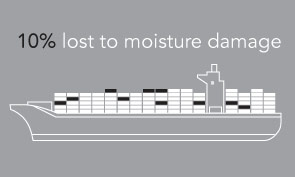
Loading often happens close to the ocean. This can result in high levels of moisture within containers. And if a container was loaded in the rain, the water on the contents will evaporate when the container gets hot and condense again when it cools.
The packing and packaging materials contribute to the moisture content inside the container. This increases the risk of problems with condensation.
On its voyage, the temperature inside a container can change significantly, both because of the changing climate during the voyage and the temperature differences between day and night. Evaporation will occur during warm phases, with condensation occurring as the container cools down.
Lack of ventilation in a container obstructs the flow of air, which can cause a build up of moisture. The more air that circulates in a container, the less the contrast between the temperature inside and out, reducing the risk of condensation.
How often is the container being moved? How often will it be opened and closed? At what time of day? In what weather conditions? These factors can affect the level of moisture in the container and the level of condensation that will result.
You can’t control the weather. But you can eliminate the threat of container rain. Cordstrap Moisture Control has been specifically designed to prevent all risks of moisture damage to cargo within containers.

For expert advice on cargo securing solutions contact us now
Contact now